What You Must Check On Your Home After a Storm
After prioritizing the safety of everyone in the home, you can look at what happened after a storm. Your home has seemingly endless parts. Every storm variety can negatively impact even the smallest nooks.
Once the intensity of the rain, sand or thunder subsides, run through a checklist to ensure everyone continues to stay safe. Checking your home after a storm will save money and your family’s health.
Contents
1. Roofing
The best method for checking a house after a storm is to start at the top and work your way down. Every building aspect above affects what lies below. Imagine if there’s a hole in the roof — another slight rain could cause furniture and floor damage, among other structural issues if you don’t tend to it immediately. Only climb atop your roof after checking the weather report and practicing proper safety so no surprises cause unintentional harm.
Debris like branches and leaves, rocks, soil and sand can all weigh down a roof, devaluing structural integrity. After cleaning the mess responsibly, you can assess for missing shingles, holes, split seams and dents in the foundation. Keep an eye out for minor defects as well, because if you overlook them now, they can exacerbate later if severe weather returns.
2. Attics
As noted, the damage from above influences aspects of the home below. Though you may rarely visit your attic, don’t ignore it during a post-storm evaluation. Plus, an uncluttered roof doesn’t always mean a clear attic. If debris or water is collecting even in the attic that’s more of a crawl space, neglecting it could mean surprise issues in the future.
3. Gutters, Soffits and Fascias
Gutters accumulate debris and water without the help of a storm, so it’s particularly crucial to review them now. Here are some red flags to look out for when assessing potentially damaged gutters:
- Buckling and sagging
- Overflowing or water coming from places they shouldn’t
- Cracks and leaking
- Broken, split, bent or damaged parts
- Unlevel troughs
Around the gutters are the soffits and fascia’s, which could have holes, chipped paint and water damage. Ensure damages aren’t causing underlying concerns like a loose foundation that could cause parts of it or an entire gutter system to fall.
4. Chimneys
Depending on the material makeup of your chimney, exercise caution when looking for damaged bricks and stone. However, the focal point should be the flashing, as damage to this essential element could cause water to leak throughout the home and onto roof beams or flooring.
5. Walls, Windows and Doors
Water, wind and other natural damage can do a number on every wall facet, including windows, doors and paint. Debris builds up in small spaces, hail creates holes and dents and fallen trees could break the glass — this is on top of expected water damage.
It’s vital to look at the walls from the inside and outside. Just because the storm occurred outdoors doesn’t mean the storm’s power doesn’t cause damage within. Shutters could fly open and slice thin walls and sealants like weatherstripping and caulking may need redoing.
6. Foundation
Houses near water, hills and mountains or flood plains especially need to analyze their foundation. It isn’t just about floorings, like waterlogged hardwood or warping laminate — it also includes basements, underground nooks and crawl spaces. Water can pool in these areas causing water damage or promoting the growth of bacteria, mold or mildew.
If your home has a carport or is a pile dwelling, it’s essential to verify the wellness of the piles and clear any debris underneath. Especially if the stilts are wooden, it will only cause rot if the area isn’t cleared and dried.
7. Other Structures on the Property
After the home is safe and secure, it’s time to venture out and check on the rest of the property. Here are some structures you may want to check for damage:
- Sheds and workshops, especially if loaded with tools and machinery
- Fences and boundaries
- Landscaping, like fallen trees or blown shrubbery
- Garden plots or farm buildings
- Pools, hot tubs and fountains
- Driveways, sidewalks and other walkways
Treading the property after a storm can be dangerous, especially if large trees are compromised or dangling cords and wires from power lines. Seek professional assistance if there are concerns.
8. Personal Items
Your house is a collection of hard work and dedication, full of nostalgia and potentially expensive materials. Take time to look at the state of appliances, electronics, collectibles and other prized possessions. Insurance may cover the cost of broken or otherwise damaged items.
Assessing Storm Damages
Checking your home after a storm is the best way for long-term safety and health. Waiting too long to address structural damage can cost unnecessary financial and emotional stress in the future.
Even if you live in an area prone to storms, it shouldn’t make you complacent — just because more storms may come doesn’t mean it’s a waste to spend money and time on repairs now. Reinforcing your home’s strength will increase stability and safety during severe weather events, so check the entire house after every storm.




